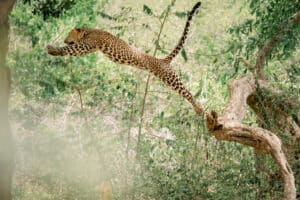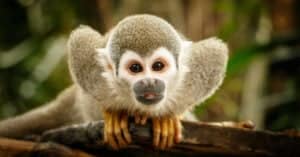Monkeys thrive on continents and islands across the globe, so it is natural to ask whether there are monkeys in Hawaii. The island looks like it would be a wonderful home to monkey population because of its lush vegetation and forests. Still, the island has no monkeys at all. Let’s find out why.
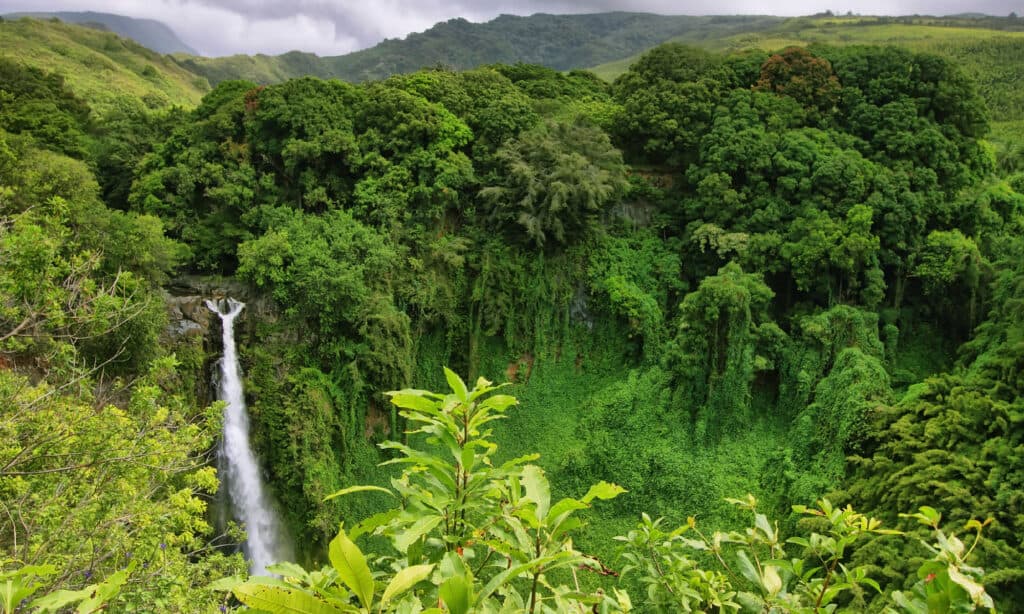
Are there monkeys in Hawaii? If you look at the beautiful Makahiku Falls and lush vegetation, it is surprising to learn that there are no monkeys in Hawaii.
©iStock.com/estivillml
There Are No Monkeys in Hawaii
Hawaii is not home to any wild monkeys at the moment or in the past. Approximately 2,500 miles of ocean separate the island from the nearest land source, resulting in few land animals being native to the island. However, people did introduce many land animals to Hawaii in the past. For example, in the 1800s and early 1900s, human settlers brought pigs, goats, horses, mongooses, and other animals onto the island. Still, Hawaii is home to two native mammals: the hoary bat and monk seal. The island also has five species of reptiles and amphibians that are indigenous.
Why Are There No Monkeys in Hawaii?
During the Eocene Epoch period, which was 56 to 33.9 million years ago, monkeys lived in North America. During this period, the earth was much warmer, which meant that tropical rainforests covered most of the planet, even Alaska. Researchers have found that monkeys, like the 55-million-year-old Teilhardina magnoliana, an ancestor of the tarsier, used to live in Mississippi.
However, once the Eocene Epoch period ended, the Drake Passage that stretched from Antarctica to South America also disappeared. This disappearance meant that the Pacific and Atlantic Oceans joined. Because of this fusion, colder currents spread across the planet, and the earth’s surface temperature dropped. This massive change caused the Grande Coupure, one of the most significant mass extinction events, leading to the extinction of monkeys in North America.
But during this time, Hawaii did not exist. The Hawaiian Islands are relatively young, being 5.1 to 7 million years old. The island of Kauai is the oldest. Suppose monkeys still lived in North America when Hawaii was formed. In that case, monkeys may have been able to travel to Hawaii via vegetation rafts. Rafting across oceans between continents is quite common for animals, especially after being displaced due to massive weather events. At that time, Africa, South America, and other continents were closer. The trip may not have been easy, but it was shorter, which meant they had a higher likelihood of surviving the voyage.
Hawaii’s State Bird
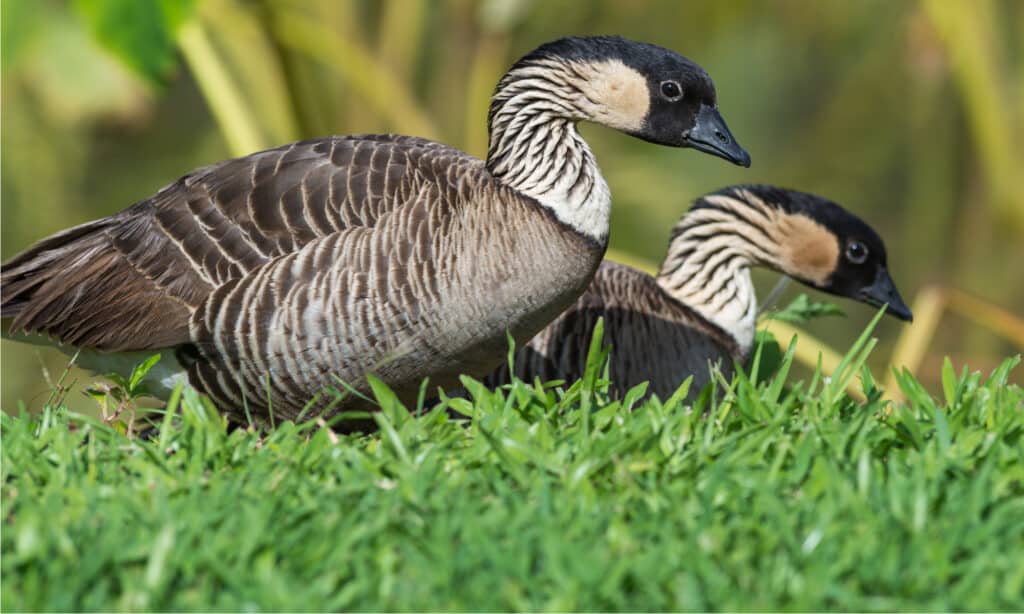
The Nene, also known as the Hawaiian
Goose
is a national emblem. Sadly, the nene is also extremely
endangered
,
©Christian Weber/Shutterstock.com
The Nene, also known as the Hawaiian Goose, is Hawaii’s state bird. Experts believe the Nene evolved from the Canadian goose. However, the Canadian goose probably evolved into a distinct species and is now a Hawaiian native. This goose has a black head with a white and black striped neck. Alternating brown and white feathers cover their bodies. Males and females look alike, except the males are larger. The Hawaiian goose is non-migratory and semi-terrestrial. This behavior means they have less toe webbing compared to other geese. The Nene eat dry grass and native shrubs found in lava fields in the wild. These geese get most of their water intake by consuming berries.
Hawaii’s State Fish
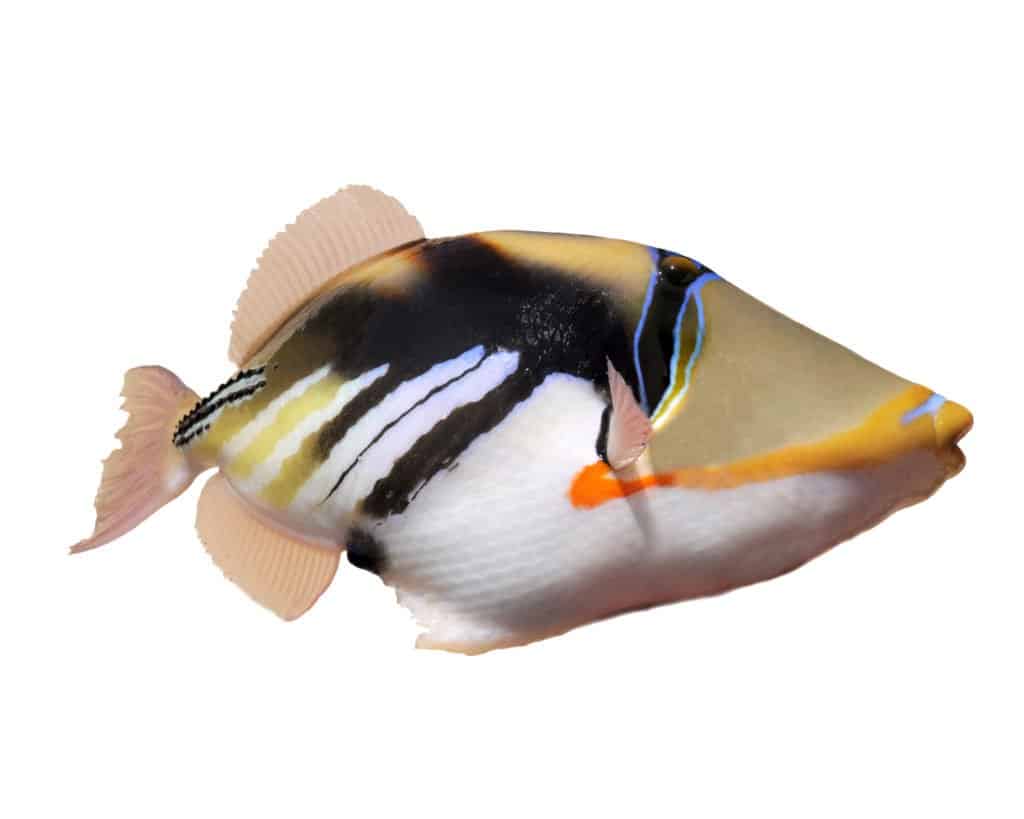
The Humuhumunukunukuapua’a is the official
fish
of Hawaii. These fish are aggressive and have been known to attack people.
©Melissa Brandes/Shutterstock.com
The Humuhumunukunukuapua’a, also known as the Hawaiian trigger fish or reef trigger fish, is the state fish of Hawaii. The humuhumunukunukuapua’a is typically green or brown with orange markings and blue lips. In addition, these fish have a diagonal black marking down the side and streaks of yellow along their back. The Hawaiian trigger fish grow to 12 inches long and can weigh up to four pounds. These fish are aggressive, with reports of them biting swimmers. The humuhumunukunukuapua’a occupies lagoons, tide pools, coral reefs, and feasts on small fish, crabs, shrimp, and other invertebrates.
Official Mammal of Hawaii
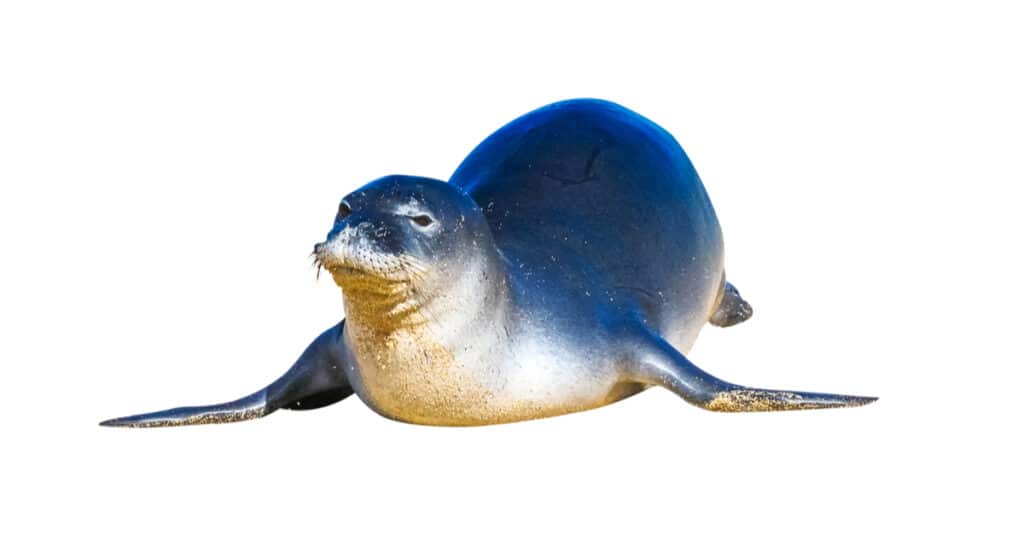
The
Hawaiian monk seal
is the official mammal of Hawaii.
©Benny Marty/Shutterstock.com
The Hawaiian monk seal is the official mammal of Hawaii. The seal’s native name is Ilio-holo-i-ka-uaua, meaning the dog that runs in rough water. Hawaiian monk seals are native to the island and are endangered. The infants are black, and the adults are usually dark gray or brown. Their bellies are either light gray to yellowish brown. Hawaiian monk seals have marks resembling scars or natural bleach marks on their fur. These seals have a vast diet and are known as generalist feeders. Their diets usually consist of:
- Fish
- Squid
- Octopus
- Eels
- Crustaceans
Official Aquatic Mammal of Hawaii

The
humpback whale
is Hawaii’s official overall state animal.
©Paul S. Wolf/Shutterstock.com
The humpback whale is Hawaii’s official aquatic mammal and overall state animal. This choice is no surprise, as the humpback whale has high cultural significance and is one of many Hawaiian emblems. The indigenous Hawaiian people believe that their aumakua or family ancestors take the shape of the humpback whale in their dreams or visions to provide them with guidance. Humpback whales are usually black with white on their pectoral fins, bellies, and tails. The tails of these whales can be up to 18 feet wide, with serrations along the trailing edge. Their tails range in pigmentation and often reflect prominent scars. These gigantic mammals are filter feeders, consuming small crustaceans, mainly krill and small fish.
Dangerous Animals in Hawaii
Hawaii is safe for people as there are not many dangerous or poisonous animals on and around the island. But there are a few animals that humans should avoid. Hawaii is home to sea snakes, like the Yellow-Bellied Sea Snake, that may be dangerous to swimmers. Hawaii’s waters are also home to sharks, like the tiger and the great white sharks. Shark attacks are not common but can often be fatal. What is comforting is that there have only been 11 fatal shark attacks in Hawaii since 1828. Hawaii is also home to the Conus snail, which has a toxin that is deadly for people.

Yellow-Bellied
Sea Snakes can pose a danger to swimmers in Hawaiian waters
.
©Ken Griffiths/Shutterstock.com
Up Next: More About Monkeys Around the World
- The 10 Smallest Monkeys in the World
- What Do Monkeys Eat? Their Diet Explained
- The World’s 10 Largest Monkeys
- Baby Monkey: 5 Pictures and 5 Facts
The photo featured at the top of this post is © iStock.com/AlexeyKamenskiy
Sources
- Reference / Staff Writer, Available here: https://www.reference.com/pets-animals/monkeys-hawaii-bd57231498495904
- Honnolulu Zoo Society, Available here: https://www.honoluluzoo.org/animals/hawaiian-goose-nene/#1554430928820-e9233c93-2432
- Boss Frog's, Available here: https://bossfrog.com/humuhumunukunukuapuaa-hawaiis-state-fish/maui-activities/
- NOAA Fisheries, Available here: https://www.fisheries.noaa.gov/species/hawaiian-monk-seal
- NOAA Fisheries, Available here: https://www.fisheries.noaa.gov/species/humpback-whale
- Science Alert / JOSH HRALA, Available here: https://www.sciencealert.com/why-are-there-no-monkeys-in-north-america
FAQs (Frequently Asked Questions)
Are there monkeys in Hawaii?
Hawaii is not home to any wild monkeys at the moment or in the past. Approximately 2,500 miles of ocean separate the island from the nearest land source, resulting in few land animals being native to the island.
Thank you for reading! Have some feedback for us? Contact the AZ Animals editorial team.




